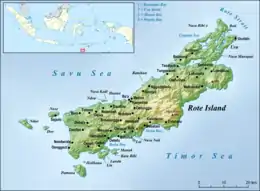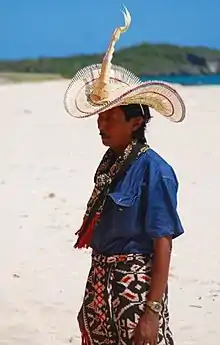Rote Island
Rote Island (Indonesian: Pulau Rote, also spelled Roti) is an island of Indonesia, part of the East Nusa Tenggara province of the Lesser Sunda Islands. According to legend, this island got its name accidentally when a lost Portuguese sailor arrived and asked a farmer where he was. The surprised farmer, who could not speak Portuguese, introduced himself, "Rote".
_123.05527E_10.71620S.png.webp) Satellite photo of Rote. | |
 Map of Rote. | |
| Geography | |
|---|---|
| Location | Southeast Asia |
| Administration | |
| Province | East Nusa Tenggara |
| Regency | Rote Ndao |
| Additional information | |
| Time zone | |
Geography
Rote lies 500 km (310.686 miles) northwest of the Australian coast and 150 km (105.633 miles) north of the Ashmore and Cartier Islands. The island is situated to the southwest of the larger island of Timor. To the north is the Savu Sea, and to the south is the Timor Sea. To the west lie Savu and Sumba. The uninhabited Pamana (or Ndana) island, just south of Rote, with an area of 14 km2 (5 sq mi), is the southernmost island of Indonesia. Along with some other nearby small islands, such as Nuse Island and Ndao island to the west of Rote, it forms the kabupaten (regency) of Rote Ndao Regency, which in the 2020 decennial census recorded a population of 143,764;[1] the official estimate as at mid 2022 was 148,811.[2] Rote island has an area of 1,280.10 km2 (494 sq mi) (including offshore islands).
The main town, Ba'a, is located on the northern side of the island. Rote has a good surf area in the south, around the village of Nembrala.
For the most part, the island is covered by grassland and palms. This island experiences tropical savanna climate (Aw) with dry months for much of the year because of the dry winds that blow from mainland Australia. The main rainfall usually occurs between November and March. Between 80% and 95% of all rain falls during the wet west monsoon period and with little or no rain falling between July and October. The mean rainfall for Rote Island is around 1,200 to 1,300 mm annually. During the dry season, many streams and rivers run dry and local inhabitants must rely only on wells for their water supplies.
Transportation
There is a daily ferry to the island from Kupang, the provincial capital on West Timor, which provides transport for local passengers and goods as well as tourists. The trip between Kupang and Ba'a takes around two hours. The ferry leaves at 8.30 AM and costs 80,000 Indonesian rupiah. Fare in 2023 is 202,000 IDR.[3]
Wings Air operates daily flights between Rote's David Constantijn Saudale Airport and Kupang's El Tari International Airport. Flight time is about 30 minutes.
Rote consists of rolling hills, terraced plantations, acacia palm, savanna and some forests.
Economy

The Rotinese depend, like the Savunese, on the lontar palm not only for basic survival but also as a supplement to their income from fishing and jewelry making.
Agriculture is the main form of employment. Fishing is also important, especially in the eastern village of Papela (east of Londalusi in the map), which has led to disputes with Australia over the water between them.[4]
Tourist attractions
Rote has many historical relics including fine antique Chinese porcelain, as well as ancient arts and traditions. Several prominent Indonesian figures were born in Rote. A popular music instrument, Sasando, is made of palm leaves.
In the eastern part of the island is a pond in Landu Village that has non-poisonous jellyfish. The pond also has a white sandy beach.[5]
Rote Island, also known as Rote Ndao, is an island consisting of 96 small islands and 6 of them are inhabited. Many islands have natural beaches and other natural and frequent tourism, but so far only local tourists often come to Rote. 10 of the most famous tourist attractions in Rote that are Bo'a beach, Nemberala beach,[6] Lutu Babatu beach, Falii water located in West Rote, Oesosole beach in East Rote, Termanu stone in central Rote, Laguna Nirwana in Southwest Rote, Oekode Waterfall, Zero Point Rote and Inaoe beach in South Rote.[7]
Culture
The ti'i langga is a traditional hat with a horn-like protrusion at the top that is a symbol of Rote cultural identity.[8]
There are many languages spoken on the island, all related to the languages on nearby Timor island. These languages are: Bilba, Dengka, Lole, Ringgou, Dela-Oenale, Termanu, and Tii.
Trivia
The critically endangered Rote Island snake-necked turtle is endemic to Rote Island.
The US-born Australian scholar, James J. Fox, has written extensively about Rotinese culture.
Gallery
 The Beach on Nusa Manuk (Manuk Island), South West Rote
The Beach on Nusa Manuk (Manuk Island), South West Rote A Raja (traditional king) of Rote wearing the ti'i langga
A Raja (traditional king) of Rote wearing the ti'i langga A Rotenese drummer with traditional hat
A Rotenese drummer with traditional hat Korbafo chief with warriors, 1900
Korbafo chief with warriors, 1900.jpg.webp) Two Rotenese (Koa Fola dan Besi Fola, 1812–1816)
Two Rotenese (Koa Fola dan Besi Fola, 1812–1816)
See also
References
- Badan Pusat Statistik, Jakarta, 2021.
- Badan Pusat Statistik, Jakarta, 2023.
- "Rote Island — West-Timor.Info". west-timor.info. Archived from the original on 2018-10-05.
- Jill Elliott, 1996, "Fishing in Australian Waters," Inside Indonesia vol. 46 http://www.insideindonesia.org/fishing-in-australian-waters; Richard Tanter, 2000, "After fear, before justice: Indonesia and Australia over the long haul, as if ethics mattered." Inside Indonesia vol. 61 http://www.insideindonesia.org/after-fear-before-justice-3
- "Tujuh Danau Ubur-Ubur Unik di Indonesia". Retrieved November 5, 2014.
- Caratri, Endah (2019-06-17). "Indahnya Pantai Nembrala di Pulau Rote". Berita Daerah. Retrieved 2021-03-16.
- "Most Famous Tourist Attractions In Rote Island Indonesia". Retrieved August 7, 2019.
- Caratri, Endah (2021-01-27). "Tiga Fakta Unik Pulau Rote". Berita Daerah. Retrieved 2021-03-15.
Further reading
- James J. Fox's book – Fox, James J (1977), Harvest of the palm : ecological change in eastern Indonesia, Harvard University Press, ISBN 978-0-674-38111-7